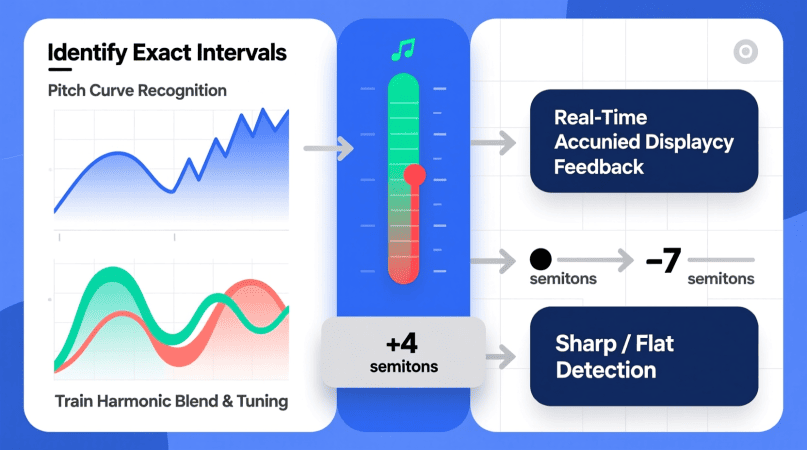
Musicians and singers know that good ears make better performers. The ability to recognize, sing, and stay in tune across intervals, scales, and harmonies is crucial — and now, the Voice Pitch Analyzer makes ear training visual, interactive, and measurable.
This guide explains how to use the analyzer for advanced ear training, from mastering intervals to singing in harmony.
Why Ear Training Matters
Ear training builds the connection between what you hear and what you produce vocally or instrumentally. Benefits include:
- Accurate Pitch Production: Sing or play notes without relying on external instruments.
- Improved Intonation: Stay in tune across scales and songs.
- Harmony Awareness: Blend multiple parts confidently.
- Musical Memory: Recognize intervals, chords, and progressions faster.
The Voice Pitch Analyzer adds a visual feedback layer to this process.
Getting Started with the Voice Pitch Analyzer
- Open the Tool: Voice Pitch Analyzer
- Allow Microphone Access: All processing is done locally for privacy.
- Start Simple: Begin with single-note pitch checks before moving to intervals or harmonies.
- Watch the ±Cents Reading: Aim for 0–5¢ deviation for accurate intonation.
Interval Training with the Analyzer
Intervals form the backbone of melodies and harmonies.
Exercise 1: Ascending Intervals
- Sing C → E → G → C (3rd, 5th, octave).
- Check each note’s accuracy on the analyzer.
- Repeat slowly before increasing tempo.
Exercise 2: Descending Intervals
- Reverse the pattern: C → A → F → C.
- Focus on pitch stability while descending.
Exercise 3: Interval Recognition
- Have a teacher or partner play a note.
- Sing the interval they call out (e.g., “major third”).
- Use the analyzer to confirm pitch accuracy visually.
For full accuracy drills, see Singing Pitch Accuracy Exercises.
Harmony & Chord Training
1. Singing Thirds & Fifths
- One singer holds the root note.
- Another sings the third or fifth above.
- Watch the analyzer to keep both pitches stable.
2. Triad Building
- Sing root → third → fifth sequentially.
- Combine voices or sing sequentially for chord awareness.
3. Two-Part Harmony
- Teacher or partner sings one line.
- You sing a harmony part while watching ±cents for tuning precision.
For choir-specific tips, check Choir Practice with the Voice Pitch Analyzer.
Quick Recap Table
| Training Type | Purpose | Tool Benefit |
|---|---|---|
| Interval Accuracy | Intonation across distances | Visual ±cents pitch feedback |
| Interval Recognition | Ear training for intervals | Immediate note confirmation |
| Harmony Building | Blending voices | Check multiple parts in real time |
| Triad & Chord Practice | Harmony awareness | Root, third, fifth stability |
Common Issues & Fixes
- Pitch drifting on intervals: Slow down; aim for 0–5¢ stability.
- Harmony clashes: Practice individual lines before combining.
- Flat endings: Support with stronger breath control.
FAQs
1. Can beginners use interval training?
Yes, start simple with thirds and fifths before tackling complex intervals.
2. Does the analyzer work for group harmony?
Yes, but best results come with 2–3 singers at a time or individual practice first.
3. Can I analyze recorded harmonies?
Yes, use the Audio-File Pitch Detector for recordings.
4. How often should I train?
10–15 minutes, 3–4 times a week builds steady progress.
Pitch Detector is a project by Ornella, blending audio engineering and web technology to deliver precise, real-time pitch detection through your browser. Designed for musicians, producers, and learners who want fast, accurate tuning without installing any software.
